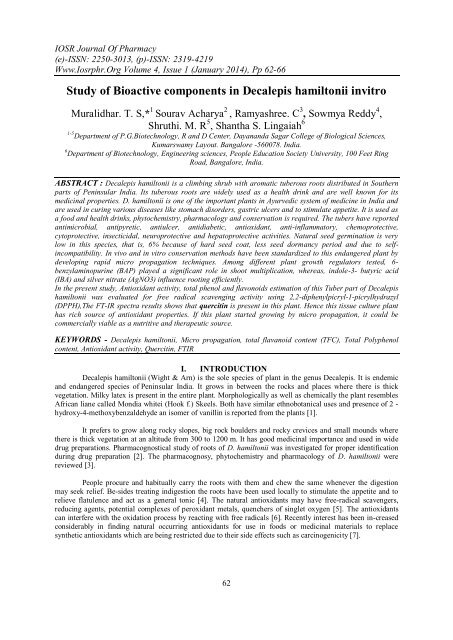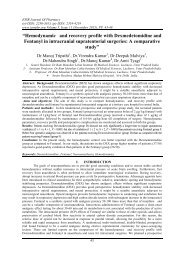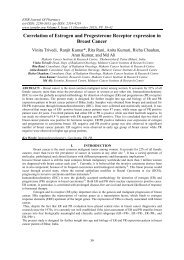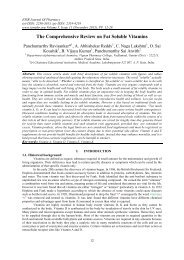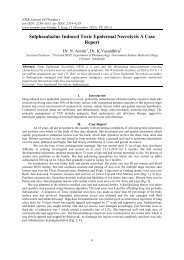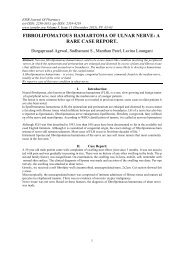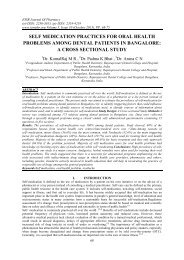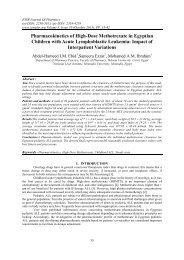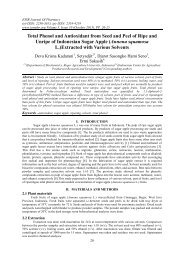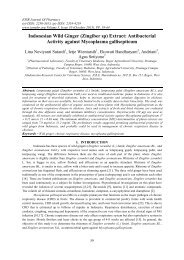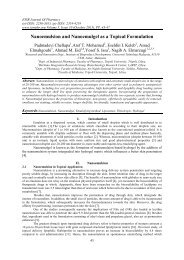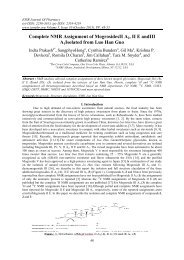Study of Bioactive components in Decalepis hamiltonii invitro
You also want an ePaper? Increase the reach of your titles
YUMPU automatically turns print PDFs into web optimized ePapers that Google loves.
IOSR Journal Of Pharmacy<br />
(e)-ISSN: 2250-3013, (p)-ISSN: 2319-4219<br />
Www.Iosrphr.Org Volume 4, Issue 1 (January 2014), Pp 62-66<br />
<strong>Study</strong> <strong>of</strong> <strong>Bioactive</strong> <strong>components</strong> <strong>in</strong> <strong>Decalepis</strong> <strong>hamiltonii</strong> <strong>in</strong>vitro<br />
Muralidhar. T. S,* 1 Sourav Acharya 2 , Ramyashree. C 3 , Sowmya Reddy 4 ,<br />
Shruthi. M. R 5 , Shantha S. L<strong>in</strong>gaiah 6<br />
1-5 Department <strong>of</strong> P.G.Biotechnology, R and D Center, Dayananda Sagar College <strong>of</strong> Biological Sciences,<br />
Kumarswamy Layout. Bangalore -560078. India.<br />
6 Department <strong>of</strong> Biotechnology, Eng<strong>in</strong>eer<strong>in</strong>g sciences, People Education Society University, 100 Feet R<strong>in</strong>g<br />
Road, Bangalore, India.<br />
ABSTRACT : <strong>Decalepis</strong> <strong>hamiltonii</strong> is a climb<strong>in</strong>g shrub with aromatic tuberous roots distributed <strong>in</strong> Southern<br />
parts <strong>of</strong> Pen<strong>in</strong>sular India. Its tuberous roots are widely used as a health dr<strong>in</strong>k and are well known for its<br />
medic<strong>in</strong>al properties. D. <strong>hamiltonii</strong> is one <strong>of</strong> the important plants <strong>in</strong> Ayurvedic system <strong>of</strong> medic<strong>in</strong>e <strong>in</strong> India and<br />
are used <strong>in</strong> cur<strong>in</strong>g various diseases like stomach disorders, gastric ulcers and to stimulate appetite. It is used as<br />
a food and health dr<strong>in</strong>ks, phytochemistry, pharmacology and conservation is required. The tubers have reported<br />
antimicrobial, antipyretic, antiulcer, antidiabetic, antioxidant, anti-<strong>in</strong>flammatory, chemoprotective,<br />
cytoprotective, <strong>in</strong>secticidal, neuroprotective and hepatoprotective activities. Natural seed germ<strong>in</strong>ation is very<br />
low <strong>in</strong> this species, that is, 6% because <strong>of</strong> hard seed coat, less seed dormancy period and due to self<strong>in</strong>compatibility.<br />
In vivo and <strong>in</strong> vitro conservation methods have been standardized to this endangered plant by<br />
develop<strong>in</strong>g rapid micro propagation techniques. Among different plant growth regulators tested, 6-<br />
benzylam<strong>in</strong>opur<strong>in</strong>e (BAP) played a significant role <strong>in</strong> shoot multiplication, whereas, <strong>in</strong>dole-3- butyric acid<br />
(IBA) and silver nitrate (AgNO3) <strong>in</strong>fluence root<strong>in</strong>g efficiently.<br />
In the present study, Antioxidant activity, total phenol and flavonoids estimation <strong>of</strong> this Tuber part <strong>of</strong> <strong>Decalepis</strong><br />
<strong>hamiltonii</strong> was evaluated for free radical scaveng<strong>in</strong>g activity us<strong>in</strong>g 2,2-diphenylpicryl-1-picrylhydrazyl<br />
(DPPH),The FT-IR spectra results shows that quercit<strong>in</strong> is present <strong>in</strong> this plant. Hence this tissue culture plant<br />
has rich source <strong>of</strong> antioxidant properties. If this plant started grow<strong>in</strong>g by micro propagation, it could be<br />
commercially viable as a nutritive and therapeutic source.<br />
KEYWORDS - <strong>Decalepis</strong> <strong>hamiltonii</strong>, Micro propagation, total flavanoid content (TFC), Total Polyphenol<br />
content, Antioxidant activity, Quercit<strong>in</strong>, FTIR<br />
I. INTRODUCTION<br />
<strong>Decalepis</strong> <strong>hamiltonii</strong> (Wight & Arn) is the sole species <strong>of</strong> plant <strong>in</strong> the genus <strong>Decalepis</strong>. It is endemic<br />
and endangered species <strong>of</strong> Pen<strong>in</strong>sular India. It grows <strong>in</strong> between the rocks and places where there is thick<br />
vegetation. Milky latex is present <strong>in</strong> the entire plant. Morphologically as well as chemically the plant resembles<br />
African liane called Mondia whitei (Hook f.) Skeels. Both have similar ethnobotanical uses and presence <strong>of</strong> 2 -<br />
hydroxy-4-methoxybenzaldehyde an isomer <strong>of</strong> vanill<strong>in</strong> is reported from the plants [1].<br />
It prefers to grow along rocky slopes, big rock boulders and rocky crevices and small mounds where<br />
there is thick vegetation at an altitude from 300 to 1200 m. It has good medic<strong>in</strong>al importance and used <strong>in</strong> wide<br />
drug preparations. Pharmacognostical study <strong>of</strong> roots <strong>of</strong> D. <strong>hamiltonii</strong> was <strong>in</strong>vestigated for proper identification<br />
dur<strong>in</strong>g drug preparation [2]. The pharmacognosy, phytochemistry and pharmacology <strong>of</strong> D. <strong>hamiltonii</strong> were<br />
reviewed [3].<br />
People procure and habitually carry the roots with them and chew the same whenever the digestion<br />
may seek relief. Be-sides treat<strong>in</strong>g <strong>in</strong>digestion the roots have been used locally to stimulate the appetite and to<br />
relieve flatulence and act as a general tonic [4]. The natural antioxidants may have free-radical scavengers,<br />
reduc<strong>in</strong>g agents, potential complexes <strong>of</strong> peroxidant metals, quenchers <strong>of</strong> s<strong>in</strong>glet oxygen [5]. The antioxidants<br />
can <strong>in</strong>terfere with the oxidation process by react<strong>in</strong>g with free radicals [6]. Recently <strong>in</strong>terest has been <strong>in</strong>-creased<br />
considerably <strong>in</strong> f<strong>in</strong>d<strong>in</strong>g natural occurr<strong>in</strong>g antioxidants for use <strong>in</strong> foods or medic<strong>in</strong>al materials to replace<br />
synthetic antioxidants which are be<strong>in</strong>g restricted due to their side effects such as carc<strong>in</strong>ogenicity [7].<br />
62
63<br />
<strong>Study</strong> <strong>of</strong> <strong>Bioactive</strong> <strong>components</strong>…<br />
A variety <strong>of</strong> analytical tools is available to study prote<strong>in</strong> conformation. Of these methods, Fourier<br />
Transform Infrared Spectrometry (FTIR) has proven to be the most versatile [8]. It allows analysis <strong>of</strong> prote<strong>in</strong><br />
conformation <strong>in</strong> a diverse range <strong>of</strong> environments, e.g. upon b<strong>in</strong>d<strong>in</strong>g to membranes [9], at the air-water <strong>in</strong>terface<br />
[10], <strong>in</strong> organic solvents [11], or <strong>in</strong> the dehydrated state [12 -13]. The versatility <strong>of</strong> FTIR is based on the long<br />
wavelength <strong>of</strong> the radiation, which m<strong>in</strong>imizes scatter<strong>in</strong>g problems. Fourier transform <strong>in</strong>frared (FTIR) analysis<br />
was carried out to determ<strong>in</strong>e the <strong>in</strong>volvement <strong>of</strong> the type <strong>of</strong> functional groups [14].<br />
II. MATERIALS AND METHODS<br />
2.1 Preparation <strong>of</strong> explants<br />
Healthy plants <strong>of</strong> <strong>Decalepis</strong> <strong>hamiltonii</strong> Wight & Arn, were collected from Shivamogga, Karnataka<br />
state, India, subjected for micro propagation. Axillary buds <strong>of</strong> D. <strong>hamiltonii</strong> were washed under runn<strong>in</strong>g tap<br />
water to remove soil and other superficial contam<strong>in</strong>ation. S<strong>in</strong>gle bud explants (1 cm each) with upper portion<br />
were washed with Tween 20 (5% v/v) for 5 m<strong>in</strong> followed by thorough wash<strong>in</strong>g under runn<strong>in</strong>g tap water for 15<br />
m<strong>in</strong>. The explants were surface sterilized with 0.15% (w/v) mercuric chloride for 3 to 5 m<strong>in</strong> and later r<strong>in</strong>sed 4 or<br />
5 times with sterile distilled water [15].<br />
For this experiment shoot <strong>in</strong>duction stage MS basal medium with 3% <strong>of</strong> sucrose (w/v) was used.Explants<br />
were cultured <strong>in</strong> conical flasks (150 ml) covered with non-absorbent cotton plugs and the medium was<br />
subsequently autoclaved at a temperature <strong>of</strong> 121°C for 15 m<strong>in</strong>. The growth regulators, N 6 -benzyladen<strong>in</strong>e (BA; 1.1<br />
µM), gibberellic acid (GA 3 ; 5.8 µM) were added to MS basal medium and then phlorogluc<strong>in</strong>ol (PG; 80-1600 µM)<br />
tried <strong>in</strong>dividually and <strong>in</strong> comb<strong>in</strong>ation to obta<strong>in</strong> the most suitable level for proliferation <strong>of</strong> shoots <strong>in</strong> established<br />
explants [16].<br />
The cultures were kept at an <strong>in</strong>cubation temperature <strong>of</strong> 25 0 ± 2 0 C and light for 16 hr/day us<strong>in</strong>g fluorescent<br />
lights for 30 days. S<strong>in</strong>gle shoot explant (2 cm) with a node or nodal explants was kept <strong>in</strong> flask. Rooted plantlets<br />
after 45days growth were removed from the medium, freed <strong>of</strong> agar by wash<strong>in</strong>g <strong>in</strong> runn<strong>in</strong>g tap water and planted<br />
<strong>in</strong> sand: compost mixture (1:2) for harden<strong>in</strong>g for 30 days at about 80% RH under polyethylene hoods <strong>in</strong> the<br />
greenhouse and then transplanted <strong>in</strong> the field [17].<br />
The Tuber parts collected and they were surface sterilized first with 200 ml <strong>of</strong> 70% (v/v) alcohol for 5<br />
sec, by wash<strong>in</strong>g with sterile water thrice, and then blotted with sterilized blott<strong>in</strong>g paper. About 100 g each plant<br />
part were grounded <strong>in</strong>to paste <strong>in</strong> mixer and used for extraction <strong>in</strong> dichloromethane. Dichloromethane was<br />
utilized for extraction s<strong>in</strong>ce it is permitted for extraction <strong>of</strong> oleores<strong>in</strong>s and other food constituents. Extracts were<br />
pooled and were separated with water <strong>in</strong> separat<strong>in</strong>g funnel. This extract was dried <strong>in</strong> vacuum and resuspended <strong>in</strong><br />
ethanol (1 mg mL-1) and used for further experiment at desired concentration. The dichloromethane extract<br />
dissolved <strong>in</strong> ethanol was subjected to antioxidant activity / Antiradical activity test [18].<br />
2.2 Antiradical activity test<br />
The antiradical activity <strong>of</strong> the extracts was estimated as 0.3mM solution <strong>of</strong> DPPH radical solution <strong>in</strong><br />
ethanol 90% was prepared and then 1 ml <strong>of</strong> this solution was mixed with 2.5 ml <strong>of</strong> different concentrations <strong>of</strong><br />
each extract (sample). After 30 m<strong>in</strong> <strong>in</strong>cubation <strong>in</strong> dark and at room temperature, absorbance (A) was measured<br />
at 518 nm <strong>in</strong> a SHIMADZU Multispect-1501 spectrophotometer [19].<br />
The percentage <strong>of</strong> the radical scaveng<strong>in</strong>g activity (RSA) was calculated by the follow<strong>in</strong>g equation:<br />
[A control – (A sample – A blank)]<br />
RSA% = -------------------------------------------- × 100<br />
A control<br />
Ethanol 90% (1 ml) plus each sample solution (2.5 ml) was used as a blank. DPPH solution (1 ml) plus<br />
ethanol 90% (2.5 ml) was used as a negative control. Rut<strong>in</strong> Solution (at the concentrations <strong>of</strong> 100, 50, 25, 10, 5,<br />
2.5 μg ml-1) was used as a positive control. The IC50 value for each sample, def<strong>in</strong>ed as the concentration <strong>of</strong> the<br />
test sample lead<strong>in</strong>g to 50% reduction <strong>of</strong> the <strong>in</strong>itial DPPH concentration, was calculated from the non l<strong>in</strong>ear<br />
regression curve <strong>of</strong> Log concentration <strong>of</strong> the test extract (μg ml-1) aga<strong>in</strong>st the mean percentage <strong>of</strong> the radical<br />
scaveng<strong>in</strong>g activity.<br />
2.3 Total Polyphenol content<br />
The total phenol content was determ<strong>in</strong>ed [20], with Aliquots (250 μl) <strong>of</strong> each extracts were taken <strong>in</strong> test<br />
tubes and made up to the volume <strong>of</strong> 1 ml with distilled water. Then 0.5ml <strong>of</strong> Fol<strong>in</strong>-Ciocalteu phenol reagent (1:1<br />
with water) and 2.5ml <strong>of</strong> sodium carbonate solution (20%) were added sequentially <strong>in</strong> each tube. Rapidly after<br />
vortex<strong>in</strong>g the reaction mixture, the test tubes were placed <strong>in</strong> dark for 40 m<strong>in</strong>utes and the absorbance was
<strong>Study</strong> <strong>of</strong> <strong>Bioactive</strong> <strong>components</strong>…<br />
recorded at 725nm aga<strong>in</strong>st reagent blank. All determ<strong>in</strong>ations were carried out <strong>in</strong> triplicate. The total phenolic<br />
compound <strong>in</strong> the extract <strong>in</strong> gallic acid equivalent (GAE) was calculated [21].<br />
2.4 Amount <strong>of</strong> total flavanoid content<br />
The determ<strong>in</strong>ation <strong>of</strong> the total flavanoid content (TFC) [19], with 2.5 ml <strong>of</strong> each extract solution was<br />
mixed with 2.5 ml AlCl3 reagent <strong>in</strong> ethanol 90% and allowed to stand for 40 m<strong>in</strong> at room temperature. After<br />
that, the absorbance <strong>of</strong> the mixture at 415 nm was measured with a SHIMADZU Multispect-1501<br />
spectrophotometer.Ethanol 90% (2.5 ml) plus sample solution (2.5 ml) was used as a blank. Rut<strong>in</strong> was used as a<br />
reference compound. The TFC for each extract [as μg rut<strong>in</strong> equivalents (RE) / mg <strong>of</strong> extract] was determ<strong>in</strong>ed on<br />
the basis <strong>of</strong> the l<strong>in</strong>ear calibration curve <strong>of</strong> rut<strong>in</strong> (absorbance versus rut<strong>in</strong> concentration) [21].<br />
2.5 FT-IR Spectra Analysis<br />
Standard quercit<strong>in</strong> and compound obta<strong>in</strong>ed were compared with us<strong>in</strong>g FT-IR spectra for identification<br />
and compar<strong>in</strong>g purity. The FT-IR spectrum was recorded on a Cary 640 <strong>in</strong> the form <strong>of</strong> KBr discs. The resolution<br />
was <strong>in</strong> 2 cm -1 and the scann<strong>in</strong>g range was 4000-500 cm -1 .<br />
III. RESULTS<br />
The extract was found to conta<strong>in</strong> flavor compound 2-hydroxy-4-methoxy benzaldehyde (2H4MB),<br />
which was identified by TLC [22]. The extracts were analyzed for 2H4MB content by spott<strong>in</strong>g the root extracts<br />
on TLC plate along with standard. Rf (0.47) <strong>of</strong> sample co<strong>in</strong>cid<strong>in</strong>g with that <strong>of</strong> standard 2H4MB was eluted <strong>in</strong><br />
solvent and UV spectrum was measured <strong>in</strong> spectrophotometer UV-160.<br />
3.1 Total flavonoid /phenolic content and Anti oxidant activities<br />
Total flavonoid content 26.02 ± 0.60 #<br />
Total Phenolic content<br />
70.24± 0.16 @<br />
Anti-oxidant activities 62.54 ± 0.32 *<br />
IC 50 by DPPH method (μg/ml) 46.00 +<br />
*Note: The IC 50 value <strong>of</strong> the positive control, rut<strong>in</strong>, was measured as 35.66 (34.21-36.68)<br />
μg ml-1. P < 0.005<br />
1. The IC50 values are presented with their respective 95% confidence limits.<br />
2. The TFC /TPC values are mean ± SEM <strong>of</strong> three determ<strong>in</strong>ations.<br />
3. P < 0.001*#+ @ represents homogenous subsets (one way ANOVA followed by Tuckey's post test).<br />
3.2 FT-IR SPECTRA ANALYSIS<br />
Standard quercit<strong>in</strong> and compound obta<strong>in</strong>ed were compared with us<strong>in</strong>g FT-IR spectra for identification and<br />
compar<strong>in</strong>g purity. The FT-IR spectra result shows that quercit<strong>in</strong> is present <strong>in</strong> the <strong>Decalepis</strong> <strong>hamiltonii</strong> (<strong>in</strong>vitro).<br />
These results are promissable, s<strong>in</strong>ce it happens to be due to some <strong>of</strong> the <strong>in</strong>gredients <strong>of</strong> media provided for<br />
explants to grow [23, 24].<br />
Quercit<strong>in</strong> Standard<br />
Quercet<strong>in</strong> OH 3412, 3288<br />
C=O Stretch 1610,1743<br />
Ar-O Stretch 1357<br />
<strong>Decalepis</strong> <strong>hamiltonii</strong> roots (<strong>in</strong>vitro)<br />
<strong>Decalepis</strong><br />
(<strong>in</strong>vitro)<br />
OH 3429.55<br />
C-H 2924<br />
C-O 1024<br />
C=O 1639<br />
64
<strong>Study</strong> <strong>of</strong> <strong>Bioactive</strong> <strong>components</strong>…<br />
IV. DISCUSSION<br />
<strong>Decalepis</strong> <strong>hamiltonii</strong> roots (<strong>in</strong>vitro) exhibited higher total antioxidant activity <strong>of</strong> 62.54 μmol/g. The<br />
total Phenolic content is 70.24, Total flavonoid content is 26.02 and Anti oxidant activity IC 50 by DPPH<br />
method 46.00 μg/ml, this implies that the plant extract may be useful for treat<strong>in</strong>g radical related pathological<br />
damage especially at higher concentration [25]. Polyphenols are the major plant compounds with antioxidant<br />
activity, although they are not the only ones. The antioxidant activity <strong>of</strong> phenolic compounds is reported to be<br />
ma<strong>in</strong>ly due to their redox properties [26, 27], which can play an important role <strong>in</strong> adsorb<strong>in</strong>g and neutraliz<strong>in</strong>g<br />
free radicals.In this present study the FT-IR spectra result shows that quercit<strong>in</strong> is present <strong>in</strong> the <strong>Decalepis</strong><br />
<strong>hamiltonii</strong> (<strong>in</strong>vitro) C=O Stretch.<br />
In <strong>Decalepis</strong> <strong>hamiltonii</strong> the tuberous root extract conta<strong>in</strong> the flavor compound 2-Hydroxy 4-<br />
methoxybenzaldehyde as a major compound (97%) which is extractable by steam distillation method followed<br />
by us<strong>in</strong>g dichloro methane [28]. Even <strong>in</strong> this root extract also analyzed for 2H4MB content by spott<strong>in</strong>g the root<br />
extracts on TLC plate along with standard. Rf (0.47)<br />
In one <strong>of</strong> the study, the antitumor effect <strong>of</strong> methanolic extract <strong>of</strong> <strong>Decalepis</strong> <strong>hamiltonii</strong> was assessed by<br />
elevat<strong>in</strong>g tumor weight and hematological parameters <strong>of</strong> DLA tumor bear<strong>in</strong>g mice. The antitumor activity <strong>of</strong><br />
methanolic extract <strong>of</strong> <strong>Decalepis</strong> <strong>hamiltonii</strong> is probably due to its flavanoid content [29].<br />
The roots <strong>of</strong> D. <strong>hamiltonii</strong> is a novel bioactive molecule as evident from the spectroscopic<br />
characterization and shows <strong>in</strong>secticidal activity aga<strong>in</strong>st stored product <strong>in</strong>sects by contact bioassay. S<strong>in</strong>ce the<br />
compound derived from an edible source with a long history <strong>of</strong> human use, it appears to be safe to mammals<br />
(Shereen, 2005). Hence, the compound from D. <strong>hamiltonii</strong> could belong to a new class <strong>of</strong> bio<strong>in</strong>secticide and<br />
may serve as a promis<strong>in</strong>g gra<strong>in</strong> protectant <strong>of</strong> natural orig<strong>in</strong> [30].<br />
The extract was found to conta<strong>in</strong> HMB, medullary portion was found to conta<strong>in</strong> high amount <strong>of</strong> HMB<br />
followed by peal which also showed significant antioxidant activity, but low when compared with the standard<br />
pure HMB. In D. <strong>hamiltonii</strong> among all the solvent extracts tested the methanolic and aqueous extracts showed<br />
high antioxidant activity measured as scaveng<strong>in</strong>g <strong>of</strong> DPPH [31]. Isolation <strong>of</strong> new anti oxidant compound ellagic<br />
acid from the aqueous extract <strong>of</strong> roots <strong>of</strong> D. <strong>hamiltonii</strong> and its antioxidant and cytoprotective effect were<br />
reported [32]. The aqueous extract <strong>of</strong> D. <strong>hamiltonii</strong> has boosted the antioxidant status <strong>in</strong> rat bra<strong>in</strong> and liver [33].<br />
The cytoprotective and antioxidant activity <strong>of</strong> free, conjugated and <strong>in</strong>soluble-bound phenolic acids <strong>of</strong><br />
D. <strong>hamiltonii</strong> was <strong>in</strong>vestigated. A total phenol content <strong>of</strong> 20.72, 7.97 and 11.52 mg gallic acid equivalents<br />
(GAE)/g for free, conjugated and <strong>in</strong>soluble bound phenolic acid extracts, respectively were identified. SRCP<br />
also showed higher reduc<strong>in</strong>g power and DNA protection property [34]. Superior antioxidant activity <strong>of</strong><br />
<strong>Decalepis</strong> rhizome <strong>of</strong> all the selected medic<strong>in</strong>al plants were reported [35].<br />
In one <strong>of</strong> the study shows that poly-phenols content <strong>in</strong> the aqueous root extracts <strong>of</strong> <strong>Decalepis</strong><br />
<strong>hamiltonii</strong> is high and these extracts exhibit strong antioxidant activities compared to that <strong>of</strong> the standard<br />
compounds such as α-Tocoperol, Rut<strong>in</strong> and Butylated hydroxytoluene (BHT) [36]. Hence, this <strong>in</strong>vestigation<br />
suggested that the plant naturally hav<strong>in</strong>g rich source <strong>of</strong> antioxidants could be used <strong>in</strong> the prevention <strong>of</strong> free<br />
radical diseases and general health tonic.<br />
V. CONCLUSION<br />
To conclude from the present study, Antioxidant activity, total phenol and flavonoids estimation <strong>of</strong> this<br />
Tuber part <strong>of</strong> <strong>Decalepis</strong> <strong>hamiltonii</strong> - <strong>in</strong>vitro was evaluated by free radical scaveng<strong>in</strong>g activity us<strong>in</strong>g 2, 2-<br />
diphenylpicryl-1-picrylhydrazyl (DPPH), The FT-IR spectra results shows that quercit<strong>in</strong> is present <strong>in</strong> this plant.<br />
Hence this tissue culture plant has rich source <strong>of</strong> antioxidant properties. If this plant started grow<strong>in</strong>g by micro<br />
propagation, it could be commercially viable as a nutritive and therapeutic source.<br />
VI. ACKNOWLEDGEMENTS<br />
The authors are extremely grateful to Dr. Premchandra Sagar (Vice Chairman), Dr. Krishne Gowda,<br />
Director, Dayananda Sagar College <strong>of</strong> Biological Sciences, Dr. C.D. Sagar Centre for Life Sciences, Bangalore-<br />
560078, India, for their immense guidance and support for this project.<br />
65
<strong>Study</strong> <strong>of</strong> <strong>Bioactive</strong> <strong>components</strong>…<br />
REFERENCES<br />
[1] Thornell K, Vedavathy S, Mulhooll DA and Crouch NR, Parallel usage pattern <strong>of</strong> African and Indian periplocoids corroborate<br />
phenolic root chemistry, South African Ethnobotany, , 2(2), 2000,17-22.<br />
[2] Nayar RC, Shetty JKP, Mary Z, Yoganarasimhan SN. Pharmacognostical studies on the root <strong>of</strong> <strong>Decalepis</strong> <strong>hamiltonii</strong> Wight &<br />
Arn. and comparison with Hemidesmus <strong>in</strong>dicus (L.). Proc. Indian Acad. Sci. 87B, 1978, 37-48.<br />
[3] Shefali K, Vandana P, Akhilesh S, Sandhya S. Pharmacognosy, phytochemistry and pharmacology <strong>of</strong> <strong>Decalepis</strong> <strong>hamiltonii</strong><br />
Wight & Arn. In: Dwivedi (Ed) Recent advances <strong>in</strong> prospects and potential <strong>of</strong> medic<strong>in</strong>al plants. 2009, pp. 156-161<br />
[4] Vedavathy, S. <strong>Decalepis</strong> <strong>hamiltonii</strong> Wight & Arn. – An endangered source <strong>of</strong> <strong>in</strong>digenous health dr<strong>in</strong>k. Natural Product<br />
Radiance, 3 (1), 2004, 22-23.<br />
[5] Ebadi, M. Pharmacodynamic basis <strong>of</strong> Herbal Medic<strong>in</strong>es (CRC Press, Boca Raton. 2002), pp: 86.<br />
[6] Gupta, M., Mazumder, U.K., Gomathi, P. and Kumar, R.S. Antioxidant and free radical scaveng<strong>in</strong>g activities <strong>of</strong> Ervatamia<br />
coronaria Stapf. Leaves. Iranian. J. Pharm. Res., 2004, 2,119.<br />
[7] Kumaran, A. and Karunakaran, J.R. In-vitro antioxidant activities <strong>of</strong> methanol extracts <strong>of</strong> five Phyllanthus species from India,<br />
LWT Food Sci. Technol. 2007, 40(2): 344.<br />
[8] Arrondo, J. L. R., Muga, A., Castresana, J., and God. F. M. Quantitative studies <strong>of</strong> the structure <strong>of</strong> prote<strong>in</strong>s <strong>in</strong> solution by Fourier<br />
transform <strong>in</strong>frared spectroscopy. Prog. Biophys. Mol. Biol. 1993, 59. 23-56.<br />
[9] Bandekar, J. Amide modes and prote<strong>in</strong> conformation. Biochim. Biophys. Acta, 1992.1120, 123-143.<br />
[10] Byler, D. M. and Susi, H. Exam<strong>in</strong>ation <strong>of</strong> the secondary structure <strong>of</strong> prote<strong>in</strong>s by deconvolved FTIR spectra. Biopolymers. 1986.<br />
25: 469-487<br />
[11] Jackson, M., Haris, P. I., and Chapman, D. m-IR spectroscopic studies <strong>of</strong> Caz+-b<strong>in</strong>d<strong>in</strong>g prote<strong>in</strong>s. Biochemistry. 1991, 30. 968-1.<br />
[12] Arrondo, J. L. R., Mantsch, H. H., Mullner, N., Ma, S., and Martonosi, A. Infrand spectroscopic characterization Of the structural<br />
changes connected with the El-& transition <strong>in</strong> the Ca2+-ATPase <strong>of</strong> sarcoplasmic reticulum. J. Biol. Chem. 1987. 262, 9037-9043.<br />
[13] Jackson, M. and Mantsch, H. H. Conformation <strong>of</strong> the peptide hormone somatostat<strong>in</strong> <strong>in</strong> aqueous solution and organic solvents.<br />
Vib. Spectrosc.1992a, 3. 323-326.<br />
[14] Michel L.J.et al., Cadmium accumulation by immobilized cells <strong>of</strong> a Citrobacter sp. us<strong>in</strong>g various phosphate donors. Biotechnol.<br />
Bioeng. 1986, 28, 1358-1365.<br />
[15] Bais H P, Sudha G, Suresh B & Ravishankar G A, Silver nitrate <strong>in</strong>fluences <strong>in</strong> vitro root formation <strong>in</strong> <strong>Decalepis</strong> <strong>hamiltonii</strong>. Curr<br />
Sci, 2000, 79, 894.<br />
[16] Obul Reddy B, Giridhar P & Ravishankar G A, In vitro root<strong>in</strong>g <strong>of</strong> <strong>Decalepis</strong> <strong>hamiltonii</strong> Wight & Arn. An endangered shrub, by<br />
aux<strong>in</strong>s and root promot<strong>in</strong>g agents, Curr Sci,.2001, 81, 1479.<br />
[17] Giridhar P, Rajasekaran T, Nagarajan S & Ravishankar G A, Production <strong>of</strong> 2-hydroxy-4- methoxybenzaldehyde <strong>in</strong> roots <strong>of</strong> tissue<br />
culture raised and acclimatized plants <strong>of</strong> <strong>Decalepis</strong> <strong>hamiltonii</strong> Wight and Arn., an endangered shrub endemic to Southern India<br />
and evaluation <strong>of</strong> its performance vis-à-vis plants from natural habitat, Indian J Exp Biol,. 2004. 42,106.<br />
[18] George J, Bais H P & Ravishankar G A, In vitro propagation <strong>of</strong> <strong>Decalepis</strong> <strong>hamiltonii</strong> W & A an endangered shrub through<br />
axillary bud culture, Curr Sci. 2001. 794, 408.<br />
[19] Nickavar B, Kamal<strong>in</strong>ejad M, Haj-Yahya M and Shafaghi B, Comparison <strong>of</strong> the free radical scaveng<strong>in</strong>g activity <strong>of</strong> six Iranian<br />
Achillea species. Pharm. Biol., 2006. 44. 208-212.<br />
[20] Siddhuraju, P. and Becker, K. Studies on antioxidant activities <strong>of</strong> Mucuna seed (Mucuna prurienns var. utilis) extracts and certa<strong>in</strong><br />
non-prote<strong>in</strong> am<strong>in</strong>o/im<strong>in</strong>o acids through <strong>in</strong> vitro models. J. Sci. Food Agri. 2003. 83, 1517-1524.<br />
[21] Zuhaib Zafar, Muralidhar. S. Talkad, Ch<strong>in</strong>may Bandopadhyay, Madhurima S<strong>in</strong>ha, J<strong>in</strong>nia Sarkhel “Antioxidant Activity <strong>of</strong> Five<br />
Selective Medic<strong>in</strong>al Plants”. African Journal <strong>of</strong> Scientific Research). Vol. 2,No. 1. 2011, 126 – 147.<br />
[22] Giridhar P, Rajasekaran T & Ravishankar G A, Production <strong>of</strong> a root-specific flavour compound, 2-hydroxy-4 methoxy<br />
benzaldehyde by normal root cultures <strong>of</strong> <strong>Decalepis</strong> <strong>hamiltonii</strong> Wight and Arn (Asclepiadaceae), J Sci Food Agric, 85 , 2005. 61.<br />
[23] Murthi P B R & Seshadri T R, A study <strong>of</strong> the chemical composition <strong>of</strong> the roots <strong>of</strong> <strong>Decalepis</strong> <strong>hamiltonii</strong> (Makaliveru). Proc<br />
Indian Aca Sci-A, 13. 1941. 221.<br />
[24] Nayar R C, Pattan shetty J K, Mary Z & Yoganarasimhan S N, Pharmacological studies <strong>of</strong> root <strong>of</strong> <strong>Decalepis</strong> <strong>hamiltonii</strong> W &<br />
Arn and comparison with Hemidesmus <strong>in</strong>dicus (L.) R. Br. Proc Indian Aca Sci-B, 87.1978, 37.<br />
[25] Wang, M., Li, J., Rangarajan, M., Shao, Y., La Voie, E.J., Huang. T., Ho, C. Antioxidative phenolic compounds from sage<br />
(Salvia <strong>of</strong>fic<strong>in</strong>alis). J Agric Food Chem., 46. 1998. 4869-4873.<br />
[26] Galato, D., Ckless, K., Sus<strong>in</strong>, M.F., Giacomelli, C., Ribeiro-do-Valle, R.M, Sp<strong>in</strong>elli, A. Antioxidant capacity <strong>of</strong> phenolic and<br />
related compounds: correlation among electrochemical, visible spectroscopy methods and structure-antioxidant activity. Redox<br />
Report, 6, 2001. 243-250.<br />
[27] Zheng, W., Wang, S.Y. Antioxidant activity and phenolic compounds <strong>in</strong> selected herbs. J <strong>of</strong> Agri. And Food Chem., 49, 2001.<br />
5165-5170.<br />
[28] Giridhar, P., Rajasekaran, T., Nagarajan, S., Ravishankar, G.A. Production <strong>of</strong> 2-hydroxy-4-methoxy benzaldehyde <strong>in</strong> roots <strong>of</strong><br />
tissue culture raised and acclimatized plants <strong>of</strong> <strong>Decalepis</strong> <strong>hamiltonii</strong> Wight & Arn ., an endangered shrub endemic to Southern<br />
India and evaluation <strong>of</strong> its perfor-mance vis-à-vis plants from natural habitat. Indian J. Exp Biol., 42, 2004. 106.<br />
[29] M. Devi and P. Latha. Antitumor Activity <strong>of</strong> methanolic extract <strong>of</strong> root <strong>of</strong> <strong>Decalepis</strong> <strong>hamiltonii</strong> <strong>in</strong> Dalton’s Lymphoma ascites<br />
(DLA) bear<strong>in</strong>g mice. IJPSR, VOL 4(5), 2013, 1764-1772.<br />
[30] Rajashekar, Y., Shivanandappa, T.A novel natural <strong>in</strong>secticide molecule for gra<strong>in</strong> protection. 10 th International Work<strong>in</strong>g<br />
Conference on Stored Product Protection. Julius-Kühn-Archiv, 425, 2010. 910-15<br />
[31] Srivastava A, Harish RS, Shivanandappa T. Antioxidant activity <strong>of</strong> the roots <strong>of</strong> <strong>Decalepis</strong> <strong>hamiltonii</strong> Wight & Arn. LWT-Food<br />
Sci. Technol. 39, 2006b. 1059-1065.<br />
[32] Srivastava A, Rao JM, Shivanandappa T Isolation <strong>of</strong> ellagic acid from the aqueous extract <strong>of</strong> the roots <strong>of</strong> <strong>Decalepis</strong> <strong>hamiltonii</strong>:<br />
Antioxidant activity and cytoprotective effect. Food Chem. 103,2007. 224-233.<br />
[33] Srivastava A, Shivanandappa. T. <strong>Decalepis</strong> <strong>hamiltonii</strong> roots boost antioxidant status <strong>of</strong> rat liver and bra<strong>in</strong>. J. Sci. Food Agric. 89,<br />
2009. 2461– 2466.<br />
[34] Nayaka MAH, Sathisha UV, Dharmesh SM. Cytoprotective and antioxidant activity <strong>of</strong> free,conjugated and <strong>in</strong>soluble-bound<br />
phenolic acids from swallow root (<strong>Decalepis</strong> <strong>hamiltonii</strong>). Food Chem. 119, 2010. 1307-1312.<br />
[35] Naveen S, Swamy MS, khanum F). Antioxidant potential <strong>of</strong> some common plant sources. IJPRD. 3, 2011. 154-174.<br />
[36] Ponnusamy Samydurai, Vellaichamy Thangapandian Antioxidant property and polyphenols evaluation <strong>of</strong> aqueous root extract <strong>of</strong><br />
<strong>Decalepis</strong> <strong>hamiltonii</strong> Wight & Arn. International Current Pharmaceutical Journal. 1(4), 2012. 71-76.<br />
66


